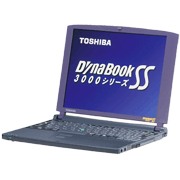Toshiba announced the DynaBook SS Portg 3000 series of slim, B5-size subnotebooks in June 1998. These subnotebooks were the world’s thinnest, at 19.8 mm, and lightest, at about 1.19 kg, B5 subnotebooks at the time. To do this, Toshiba developed and used a number of component technologies, including a slim, 8.45 mm hard drive, 0.7 mm magnesium shell, a 4.8 mm slim-profile keyboard, a 5.7 mm LCD screen, and a highly integrated chip set.
The DynaBook SS PORTÉGÉ 3000 series consisted of two models: the DynaBook SS PORTÉGÉ 3000 and the 3010. The main differences between the two were the CPU speeds and the capacities of the magnetic disk units.
The DynaBook SS PORTÉGÉ 3000 had a 233 MHz MMX Pentium CPU and a 2.1 GB magnetic disk unit, while the DynaBook SS PORTÉGÉ 3010 had a 266 MHz MMX Pentium CPU and a 4.3 GB magnetic disk unit.
- The DynaBook SS PORTÉGÉ 3000 series also had the following features.
-
- 1. For a screen, the subnotebooks used an SVGA-compatible (800 x 600) TFT LCD that could display 16.77 million colors simultaneously.
- 2. Both models were equipped with 64 MB of memory standard, which could be expanded up to 96 MB.
- 3. Despite being B5-size subnotebooks, they had two Type II PC card slots and could run for up to 3.5 hours on battery power (up to 7 hours with the add-on battery pack).
- 4. DynaBook SS Portg 3000 series subnotebooks could be connected to nearly any device by using either the optional I/O adaptor with serial, parallel, CRT, PS/2, USB, and PC card slot interfaces or the optional mini I/O adaptor with CRT and PS/2 interfaces.
Because Microsoft had just rolled out Windows 98 at the time the series was announced, the subnotebooks came with Windows 95 installed. Toshiba provided a coupon for a free upgrade to Windows 98 with the computers.


